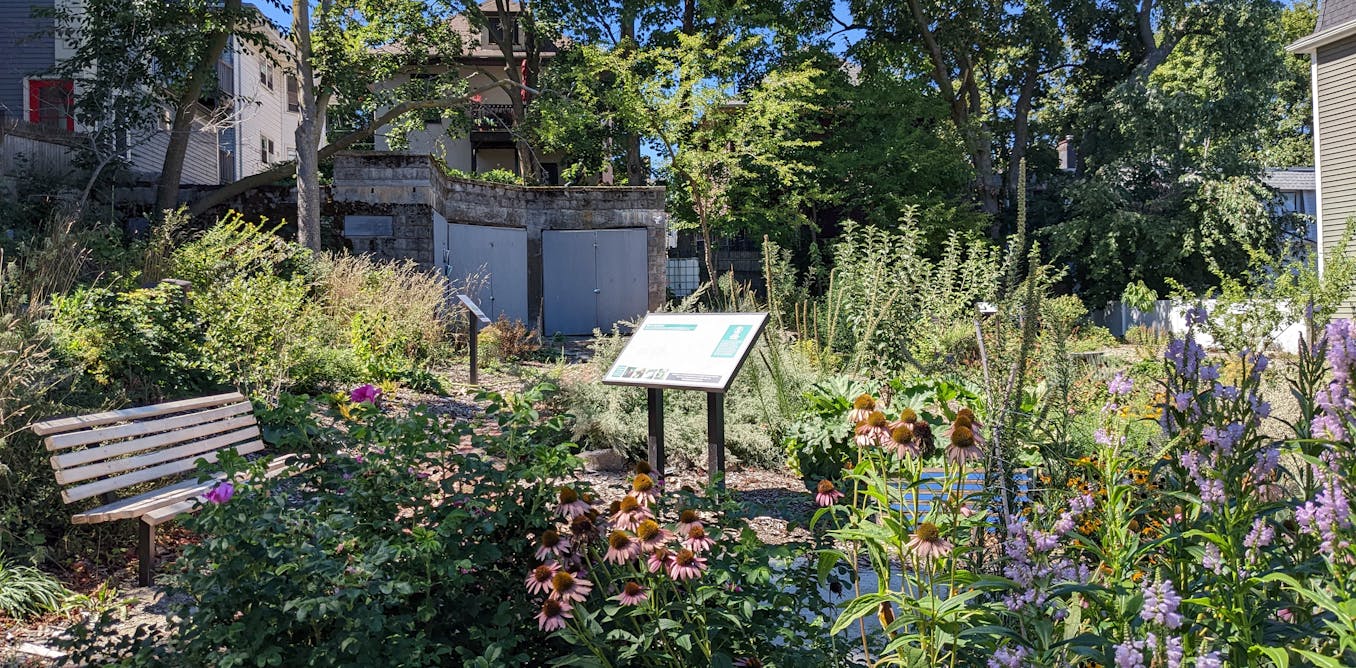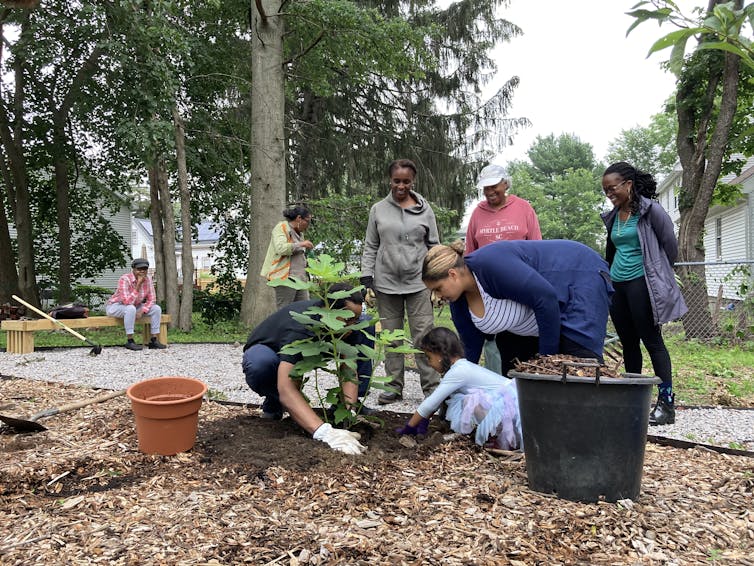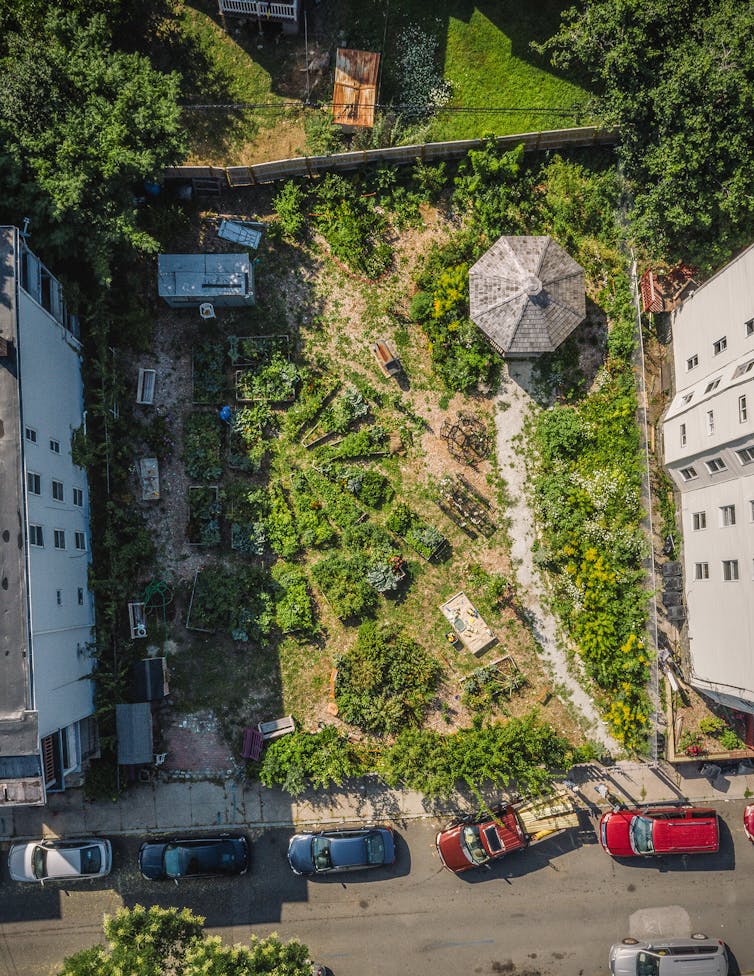Food forests are bringing shade and sustenance to US cities, one parcel of land at a time


More than half of all people on Earth live in cities, and that share could reach 70% by 2050. But except for public parks, there aren’t many models for nature conservation that focus on caring for nature in urban areas.
One new idea that’s gaining attention is the concept of food forests – essentially, edible parks. These projects, often sited on vacant lots, grow large and small trees, vines, shrubs and plants that produce fruits, nuts and other edible products.
Atlanta’s Urban Food Forest at Browns Mill is the nation’s largest such project, covering more than 7 acres.
Unlike community gardens or urban farms, food forests are designed to mimic ecosystems found in nature, with many vertical layers. They shade and cool the land, protecting soil from erosion and providing habitat for insects, animals, birds and bees. Many community gardens and urban farms have limited membership, but most food forests are open to the community from sunup to sundown.
As scholars who focus on conservation, social justice and sustainable food systems, we see food forests as an exciting new way to protect nature without displacing people. Food forests don’t just conserve biodiversity – they also promote community well-being and offer deep insights about fostering urban nature in the Anthropocene, as environmentally destructive forms of economic development and consumption alter Earth’s climate and ecosystems.
 Community stewards planting a tree at Boston’s Edgewater Food Forest at River Street, July 2021. Boston Food Forest Coalition/Hope Kelley, CC BY-ND
Community stewards planting a tree at Boston’s Edgewater Food Forest at River Street, July 2021. Boston Food Forest Coalition/Hope Kelley, CC BY-ND
Protecting nature without pushing people away
Many scientists and world leaders agree that to slow climate change and reduce losses of wild species, it’s critical to protect a large share of Earth’s lands and waters for nature. Under the U.N. Convention on Biological Diversity, 188 nations have agreed on a target of conserving at least 30% of land and sea areas globally by 2030 – an agenda known popularly as 30×30.
But there’s fierce debate over how to achieve that goal. In many cases, creating protected areas has displaced Indigenous peoples from their homelands. What’s more, protected areas are disproportionately located in countries with high levels of economic inequality and poorly functioning political institutions that don’t effectively protect the rights of poor and marginalized citizens in most cases.
In contrast, food forests promote civic engagement. At Beacon Food Forest in Seattle, volunteers worked with professional landscape architects and organized public meetings to seek community input on the project’s design and development. The city of Atlanta’s Urban Agriculture Team partners with neighborhood residents, volunteers, community groups and nonprofit partners to manage the Urban Food Forest at Browns Mill.
Block by block in Boston
Boston is famous for its parks and green spaces, including some designed by renowned landscape architect Frederick Law Olmsted. But it also has a history of systemic racism and segregation that created drastic inequities in access to green spaces.
And those gaps still exist. In 2021, the city reported that communities of color that had been subjected to redlining in the past had 16% less parkland and 7% less tree cover than the citywide median. These neighborhoods were 3.3 degrees Fahrenheit (1.8 degrees Celsius) hotter during the day and 1.9 F (1 C) hotter at night, making residents more vulnerable to urban heat waves that are becoming increasingly common with climate change.
Encouragingly, Boston has been at the forefront of the national expansion of food forests. The unique approach here places ownership of these parcels in a community trust. Neighborhood stewards manage the sites’ routine care and maintenance.
The nonprofit Boston Food Forest Coalition, which launched in 2015, is working to develop 30 community-driven food forests by 2030. The existing nine projects are helping to conserve over 60,000 square feet (5,600 square meters) of formerly vacant urban land – an area slightly larger than a football field.
Neighborhood volunteers choose what to grow, plan events and share harvested crops with food banks, nonprofit and faith-based meal programs and neighbors. Local collective action is central to repurposing open spaces, including lawns, yards and vacant lots, into food forests that are linked together into a citywide network. The coalition, a community land trust that partners with the city government, holds Boston food forests as permanently protected lands.
 Aerial view of the Ellington Community Food Forest in Boston’s Dorchester neighborhood. Boston Food Forest Coalition, CC BY-ND
Aerial view of the Ellington Community Food Forest in Boston’s Dorchester neighborhood. Boston Food Forest Coalition, CC BY-ND
Boston’s food forests are small in size: They average 7,000 square feet (650 square meters) of reclaimed land, about 50% larger than an NBA basketball court. But they produce a wide range of vegetables, fruit and herbs, including Roxbury Russet apples, native blueberries and pawpaws, a nutritious fruit native to North America. The forests also serve as gathering spaces, contribute to rainwater harvesting and help beautify neighborhoods.
The Boston Food Forest Coalition provides technical assistance and fundraising support. It also hires experts for tasks such as soil remediation, removing invasive plants and installing accessible pathways, benches and fences.
Hundreds of volunteers take part in community work days and educational workshops on topics such as pruning fruit trees in winter. Gardening classes and cultural events connect neighbors across urban divides of class, race, language and culture.
Boston residents explain what the city’s food forests mean to them.
A growing movement
According to a crowd-sourced repository, the U.S. has more than 85 community food forests in public spaces from the Pacific Northwest to the Deep South. Currently, most of these sites are in larger cities. In a 2021 survey, mayors from 176 small cities (with populations under 25,000) reported that long-term maintenance was the biggest challenge of sustaining food forests in their communities.
From our experience observing Boston’s approach close up, we believe its model of community-driven food forests is promising. The city sold land to the Boston Food Forest Coalition’s community land trust for $100 per parcel in 2015 and also funded initial construction and planting operations. Since then, the city has made food forests an important part of the city’s open spaces program as it continues to sell parcels to the community land trust at the same price.
Smaller cities with much lower tax bases may not be able to make the same sort of investments. But Boston’s community-driven model offers a viable approach for maintaining these projects without burdening city governments. The city has adopted innovative zoning and permitting ordinances to support small-scale urban agriculture.
Building a food forest brings together neighbors, neighborhood associations, community-based organizations and city agencies. It represents a grassroots response to the interconnected crises of climate change, environmental degradation and social and racial inequity. We believe food forests show how to build a just and sustainable future, one person, seedling and neighborhood at a time.
Orion Kriegman, the founding executive director of the Boston Food Forest Coalition, contributed to this article.





